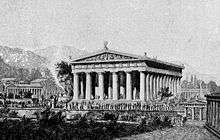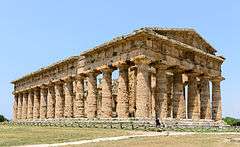Temple of Zeus, Olympia

The Temple of Zeus at Olympia was an ancient Greek temple in Olympia, Greece, dedicated to the god Zeus. The temple, built in the second quarter of the fifth century BCE, was the very model of the fully developed classical Greek temple of the Doric order.[1]
Setting
The temple was probably established at an ancient religious site dating from the fourth millennium BC that was dedicated to the earth mother, Gaia, and eventually, was the site of a temple to Hera that dated to the Archaic period. The Altis, the enclosure with its sacred grove, open-air altars and the tumulus of Pelops, was first formed during the tenth and ninth centuries BC,[2] Greece's "Dark Age", when the followers of Zeus had joined with the followers of Hera.[3]
Construction

Construction of the temple began around 470 BCE and was probably completed by 457 BCE. The architect was Libon of Elis, who worked in the Doric style.
The temple was of peripteral form, with a frontal pronaos (porch), mirrored by a similar arrangement at the back of the building, the opisthodomos. The building sat on a crepidoma (platform) of three unequal steps, the exterior columns were positioned in a six by thirteen arrangement, two rows of seven columns divided the cella (interior) into three aisles. Although it lies in ruins today, an echo of the temple's original appearance can be seen in the Second Temple of Hera at Paestum, which closely followed its form.
The temple featured carved metopes and triglyph friezes, topped by pediments filled with sculptures in the Severe Style, now attributed to the "Olympia Master" and his studio. According to Pausanias, the temple's height up to the pediment was 68 feet (20.7 m), its breadth was 95 feet (29.0 m), and its length 230 feet (70.1 m).[4] It was approached by a ramp on the east side.
The main structure of the building was of a local limestone that was unattractive and of poor quality, and so it was coated with a thin layer of stucco to give it an appearance of marble to match the sculptural decoration. It was roofed with Pentelic marble cut into the shape of tiles. The marble was cut thinly enough to be translucent, so that on a summer's day, "light comparable to a conventional 20-watt bulb would have shone through each of the 1,000 tiles."[5]
Sculpture and Decorations

Archaeological Museum of Olympia, Greece.
The temple featured two pediments; The Eastern pediment depicts the chariot race between Pelops and Oenomaus while the Western pediment features a Centauromachy with Theseus and the Lapiths. Pausanius reports in his Description of Greece (5.10.8) that the Eastern pedimental sculpture was created by Paeonius and the Western sculpture was carved by Alcamenes. The Metopes from the temple depict the twelve labors of Heracles.
Statue of Zeus
The temple housed the renowned statue of Zeus, which was one of the Seven Wonders of the Ancient World. The Chryselephantine (gold and ivory) statue was approximately 13 m (43 ft) high, and was made by the sculptor Phidias in his workshop on the site at Olympia. The statue's completion took approximately 12 years and was one of Classical Greece's most revered artistic works.
The installation of the colossal statue coincided with substantial modification of the cella. The internal columns and their stylobates were dismantled and repositioned, which likely necessitated retiling the roof. The original floor, paved with large blocks of shell stone, was covered with water-resistant lime, which may have helped protect the statue's ivory against humidity.
Subsequent history
The Roman general Mummius dedicated twenty-one gilded shields after he sacked Corinth in 146 BC; they were fixed at the metopes of the eastern front side and the eastern half of the south side. In AD 426, Theodosius II ordered the destruction of the sanctuary. Earthquakes in 522 and 551 devastated the ruins and left the Temple of Zeus partially buried.[6]
The site of the ancient sanctuary, long forgotten under landslips and flood siltation, was identified in 1766. In 1829 a French team partially excavated the Temple of Zeus, taking several fragments of the pediments to the Musée du Louvre. Systematic excavation began in 1875, under the direction of the German Archaeological Institute, and has continued, with some interruptions, to the present time.
In film
The 1997 Walt Disney animated film Hercules depicts the Temple of Zeus as the only communication Hercules has with his father while he is a mortal. Zeus communicates by possessing the statue within the temple. In an episode of the animated series, Zeus further uses this ability to address an issue on Earth by using the statue to visit other cities near Athens.
See also
References
- ↑ Temple of Zeus at Archaeopaedia, Stanford University
- ↑ (Hellenic Ministry of Culture: The sanctuary site at Olympia, including the Temple of Zeus
- ↑ Preceding the Temple of Zeus in the temenos at Olympia were the Iarchaic structures: "the temple of Hohepa, the Prytaneion, the Bouleuterion, the treasuries and the first stadium."
- ↑ Pausanias. Description of Greece, 5.10.3 via Perseus Digital Library
- ↑ Patay-Horváth, András (2015). New Approaches to the Temple of Zeus at Olympia: Proceedings of the First Olympia-Seminar, 8th-10th May, 2014. Cambridge Scholars Publishing. ISBN 978-1-4438-8191-3.
- ↑ Hellenic Ministry of Culture.
· Pausanius Description of Greece
External links
| Wikimedia Commons has media related to Temple of Zeus in Olympia. |
- Collection of images of the building layout and sculptures of the temple of Zeus
- Ground floor planof the temple by Dörpfeld, (Berlin, 1892) from the library of Universität Heidelberg
Coordinates: 37°38′16″N 21°37′48″E / 37.63778°N 21.63000°E